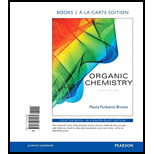
a)
Interpretation: The compounds are not optically active, the reason has to be predicted.
Concept Introduction:
Diels-Alder reaction:
A conjugated diene reacts with a compound containing a carbon-carbon double bond. It is a cycloaddition reaction, where two reactants form a cyclic product.
Conformation of Diene:
S-Cis Conformer: The double bonds are cis about the single bond (s stands for single), in an s-cis conformer.
S-trans Conformer: The double bonds are trans- about the single bond (s stands for single) in an s-trans conformer.
Condition for Diels-Alder reaction:
The conjugate diene must be in an s-cis conformation because when it is in an S-trans conformation, C-1 and C-4 are too far apart to react with the dienophile in a concerted reaction.
b)
Interpretation: The order of diene reactivity has to be predicted.
Concept Introduction:
Diels-Alder reaction:
A conjugated diene reacts with a compound containing a carbon-carbon double bond. It is a cycloaddition reaction, where two reactants form a cyclic product.
Conformation of Diene:
S-Cis Conformer: The double bonds are cis about the single bond (s stands for single), in an s-cis conformer.
S-trans Conformer: The double bonds are trans- about the single bond (s stands for single) in an s-trans conformer.
Condition for Diels-Alder reaction:
The conjugate diene must be in an s-cis conformation because when it is in an S-trans conformation, C-1 and C-4 are too far apart to react with the dienophile in a concerted reaction.
Want to see the full answer?
Check out a sample textbook solution
Chapter 8 Solutions
Organic Chemistry, Books a la Carte Edition (8th Edition)
- Write the equation for the following reactions: a. 2-butene + HCI b. 1,2-dichloro-1-propene + water c. Propyne + oxygen d. 1, 3-pentadiene + bromine e. cis-3,3,4-trimethyl-1-hexene + H₂ parrow_forwardWhat term describes the structural relationship between (2R,3R,4S)-2,3,4-trichloroheptane and (2R,3R,4R)-2,3,4-trichloroheptane? A. enantiomers B. diastereomers OO OO C. constitutional isomers D. not isomersarrow_forwardConsider the structure of cyclohexene, if it undergoes epoxidation followed by exposure to water, which of the following final product is formed? a. Cyclohexan-1,2,-diol b. Cyclohexane c. Cyclohexanone d. Hexan-1,-6-dioic acidarrow_forward
- draw and write the chemical equation of the following situations: 1. Combustion of acetylene 2. Reaction of acetylene with Potassium Permanganate 3. Reaction of acetylene with cuprous chloride in ammoniaarrow_forwardConsider the structure of cyclohexene, if it undergoes strong oxidation, which of the following final product is formed? a. Cyclohexan-1,2,-diol b. Cyclohexane c. Cyclohexanone d. Hexan-1,-6-dioic acidarrow_forwardPropene undergoes a hydration reaction with water in the presence of an acid. a. There are two possible products for this reaction, both with the formula C3H8O. Show their structural formulas and names. b. Which of the two products do you predict will form. Explainarrow_forward
- 12. Which of the following reactions is classified under addition reactions? A. Bromination of Benzene B. Hydrogenation of 2-butene C. Friedel Crafts Alkylation of Benzene D. Nitration of Toluenearrow_forwardWhich among the following compounds has the most electronegative carbon in structure? a. benzaldehyde b. benzene c. cyclobutane d. butyne The radical substitution reaction is primarily observed in the following reactions. Which reaction is it? a. Oxidation of but-2-ene b. Boiling of hex-3-ene c. Chlorination of butane d. Combustion of methane Which among the following statements is FALSE about alkanes and cycloalkanes? a. all alkanes produce CO2 and water vapor upon complete combustion b. alkanes undergo substitution reactions c. the empirical formula of all alkanes is CnH2n+2 d. cyclic alkanes exhibit bond strain in the sp#-sp# sigma bondsarrow_forwardConsider the attached picture: 1. What specific reaction is involved? a. nitration b. alkylation c. halogenation d. acylation 2. What type of reaction is involved? a. Addition Reaction b. Elimination Reaction c. Substitution Reaction 3. What are the products? a. chlorocyclohexane and hydrochloric acid b. chlorocyclobenzene and hydrochloric acid c. 1-chloro-1,3,5-cyclohexatriene and hydrochloric acid d. chlorobenzene and hydrochloric acidarrow_forward
- Consider the reaction of gaseous propene with liquid water to produce liquid 2- propanol. a. Write the balanced chemical equation for this reaction including phase labels. b. What would the Law of Mass Action be? (The specific mathematical equation for K)arrow_forwardGive equations for the following reactions and name the products: 1. Complete combustion of butane 2. Addition of bromine to propene 3. Oxidation of propan-1-ol by sodium dichromate with distillation 4. Oxidation of propan-1-ol by sodium dichromate under reflux 5. Oxidation of propan-2-ol by sodium dichromate under refluxarrow_forwardA hydrocarbon (Y) undergoes partial hydrogenation in the presence of the Lindlar catalyst to create an alkene. When (Y) is oxidatively cleaved with ozone, a single carboxylic acid product is formed. The hydrocarbon (Y) is as follows: a. cyclohexaneb. 2-hexen-1-olc. 2-hexyned. 2-butynearrow_forward
